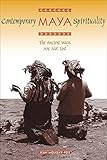Contemporary Maya Spirituality : The Ancient Ways Are Not Lost / Jean Molesky-Poz.
Material type: TextPublisher: Austin : University of Texas Press, [2021]Copyright date: ©2006Description: 1 online resource (223 p.)Content type:
TextPublisher: Austin : University of Texas Press, [2021]Copyright date: ©2006Description: 1 online resource (223 p.)Content type: - 9780292795815
- 299.7/842 22
- online - DeGruyter
| Item type | Current library | Call number | URL | Status | Notes | Barcode | |
|---|---|---|---|---|---|---|---|
 eBook
eBook
|
Biblioteca "Angelicum" Pont. Univ. S.Tommaso d'Aquino Nuvola online | online - DeGruyter (Browse shelf(Opens below)) | Online access | Not for loan (Accesso limitato) | Accesso per gli utenti autorizzati / Access for authorized users | (dgr)9780292795815 |
Frontmatter -- Contents -- Foreword -- Portal -- Acknowledgments -- Introduction -- PART 1: The Florescence of Maya Spirituality -- Chapter 1. A New Cycle of Light -- Chapter 2. Maya Cosmovision and Spirituality -- PART 2: A Cultural Inheritance -- Chapter 3. Ajq’ijab’ -- PART 3: The Aesthetics of Space, Time, and Movement -- Chapter 4. Sacred Geography -- Chapter 5. The Calendar -- Chapter 6. Ceremony -- PART 4: Thinking, Contemplating, and Acting into the Future -- Chapter 7. The Ancient Things Received from Our Parents Are Not Lost -- Notes -- Bibliography -- Index
restricted access online access with authorization star
http://purl.org/coar/access_right/c_16ec
Since the mid-1980s, when Guatemala returned to civilian rule and achieved relative peace and stability, the Maya have begun openly expressing their spiritual beliefs and practices. Jean Molesky-Poz draws on in-depth dialogues with Maya Ajq'ijab' (keepers of the ritual calendar), her own participant observation, and inter-disciplinary resources to offer a comprehensive, innovative, and well-grounded understanding of contemporary Maya spirituality and its theological underpinnings. She reveals significant continuities between contemporary and ancient Maya worldviews and spiritual practices. Molesky-Poz opens with a discussion of how the public emergence of Maya spirituality is situated within the religious political history of the Guatemalan highlands, particularly the recent pan-Maya movement. She investigates Maya cosmovision and its foundational principles, as expressed by Ajq'ijab'. At the heart of this work, Ajq'ijab' interpret their obligation, lives, and spiritual work. In subsequent chapters, Molesky-Poz explores aspects of Maya spirituality—sacred geography (the reciprocal relationship between the earth and humans, sacred places, and the significance of the cross or quatrefoil map), sacred time (how the 260-day sacred calendar is "the heart of the wisdom of the Maya," the matrix of Maya culture), and ritual practice (the distinct way and method of ancestral study, with special attention to fire ceremonialism). She confirms contemporary Maya spirituality as a faith tradition with elaborate historical roots that has significance for individual, collective, and historical lives, reaffirming its own public space and legal right to be practiced.
Mode of access: Internet via World Wide Web.
In English.
Description based on online resource; title from PDF title page (publisher's Web site, viewed 26. Apr 2022)


